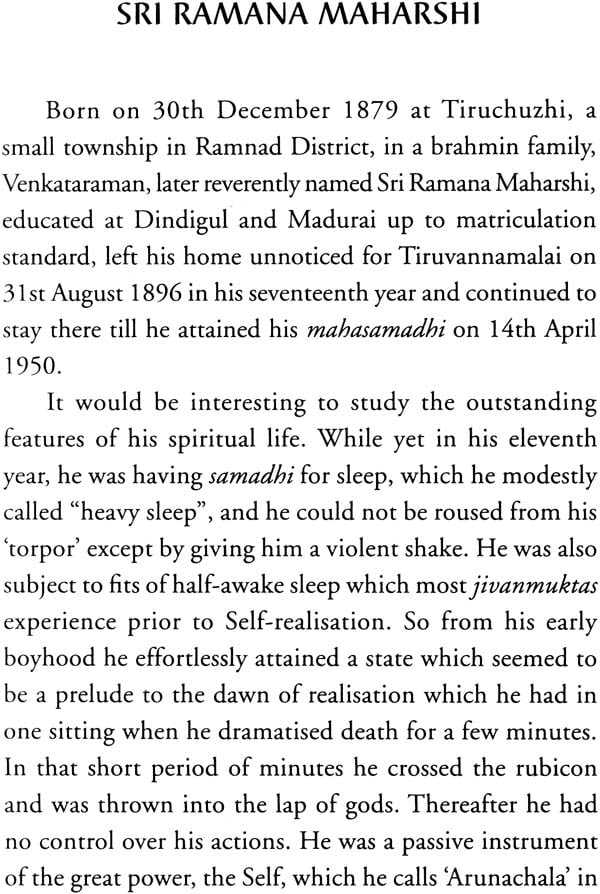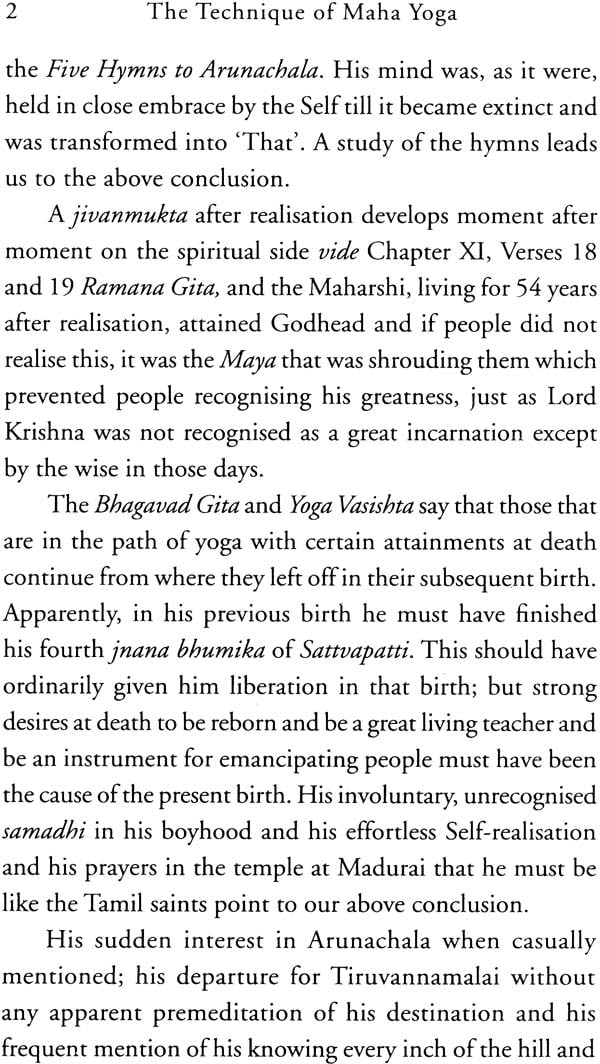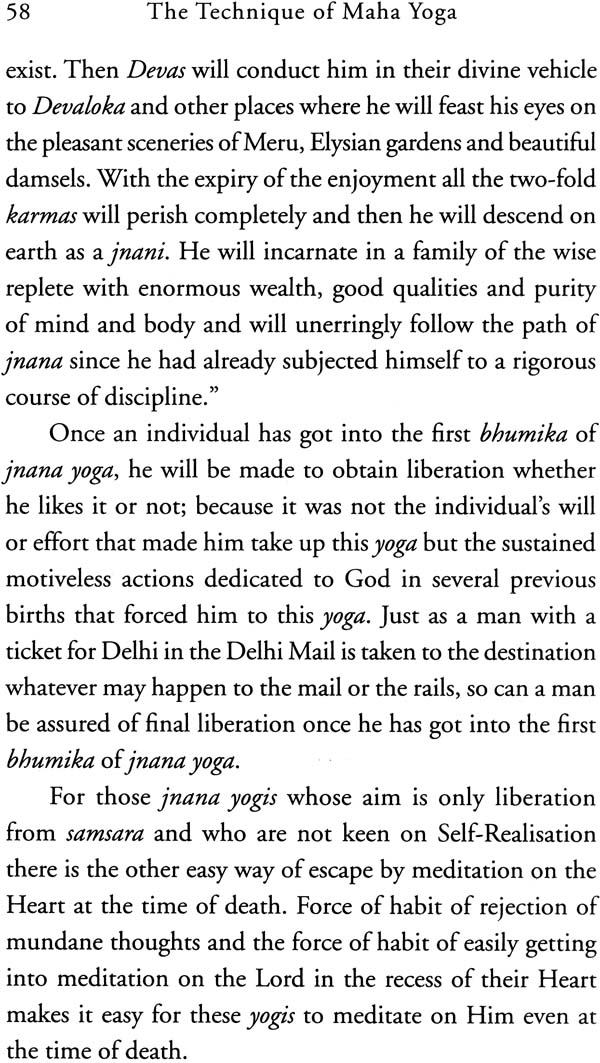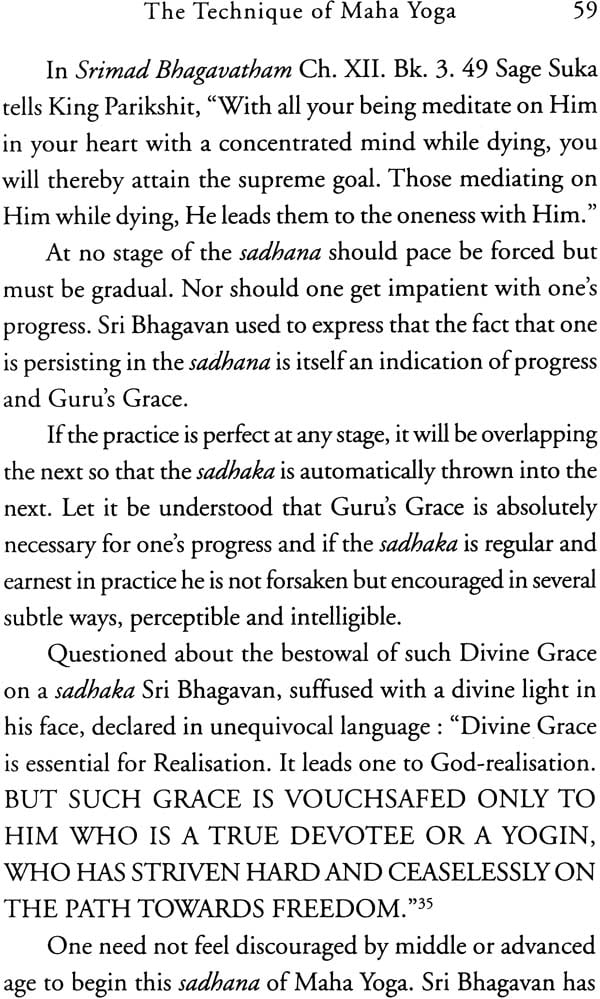
The Technique of Maha Yoga (Self Enquiry)
Book Specification
| Item Code: | NAF572 |
| Author: | N.R.Narayana Aiyer |
| Publisher: | Sri Ramanasramam, Tamil Nadu |
| Language: | English |
| Edition: | 2021 |
| ISBN: | 9788182881525 |
| Pages: | 87 |
| Cover: | Paperback |
| Other Details | 8.5 inch X 5.5 inch |
| Weight | 110 gm |
Book Description
This slim book is indeed a gem, a boon for sadhakas of Self – Enquiry as taught by the Bhagavan Ramana. Written in 1962 by a devote who was for many years in the Presence of Ramana and earnestly practiced his teaching, this book, a first-class sadhakas’ manual, anticipated every question that is apt to arise in the mind of the practicant and answers them all in Bhagavan’s own words, mostly culled from Talks With Sri Ramana Maharshi.
Every sentence in this book, written in an utterly simple, direct, clear, unpretentious language, comes out of the author’s own sadhana and experience of Bhagavan’s teaching. After reading this hard-to-put-down book, the reader is sure to be convinced that Atma-Vidya, Self Knowledge, as Ramana has assured us, is ‘easy’ indeed it is easy’. However, Ramana has stipulated: One has to go inward and investigate the source of ‘I’ with a pure mind. So, what makes Self-Knowledge difficult is the mind made impure by our vasanas, our tendencies.
This book tells us, in Bhagavan’s words, how to purify and thus still our mind, as the inevitable prelude to the dawn of Self-Realisation and how the obstacles of vasanas can surely be surmounted by sadhaka’s sincere, meticulous sadhana which will earn him the Guru’s Grace.
The author of this short work had sat at the feet of the foremost sage of the age, Sri Ramana Maharshi, for several years, in order to learn his sublime teachings. During this period he was and still is submitted himself to the strict discipline of spiritual life and regular practice.
Here in the manner of guiding the aspirants, the author is literally recording his own experience in this field in order to safeguard them against mistakes ideas and concepts for experience. To help them overcome some of the hurdles in this spiritual path, a few important sadhanas – such as japa, regulation of breath, regulated sleep, regular practice and its method are all dealt with in their proper places. Passages dealing with vasanas and different Samadhis are interesting as well as illuminating. The statements are supported by some of the highest authorities and the experiences of great sages past and present.
This book will be highly useful for the aspirants in the Jnana marga – more especially in that of vichara.
Though for some time there was an inner urge to collect the essential features of the practice of MahaYoga from the various ‘talks’ of Sri Bhagavan and concatenate them for purposes of practice for intending aspirants, there was also a certain amount of diffidence to do it, as it would be treading on virgin ground. Somehow the former urge got the better of the latter complex.
The whole range of sadhana, found scattered in the various ‘talks’, did need an arrangement. The readers and reviewers of the Asramam publications pointed out this want. Hence this treatise.
As Sri Bhagavan’s method of Maha Yoga and its treatment is original and is not had in any Vedantic books in such detail, certain portions of the book as under ‘vasanas’ and ‘stillness’ may be found to suffer from repetition; but such repetition was considered essential to bring home to the aspirant their importance in practice.
Again, in a compilation of this nature, where effort is made to reproduce, in his own words, Sri Bhagavan’s teachings, which at times, covered the whole range of the Yoga in a few connected sentences, defects, due to repetition and inappropriateness of place are inevitable and the presentation on that account may not be happy. The indulgent reader must overlook these defects.
As it was noticed in the Talks, that several visitors enquired of Sri Bhagavan as to how Self-enquiry should be practised and as several aspirants must be groping in the dark as to how it should be done, the author thought it would be useful for earnest seekers, if he delineated the method,. he adopted from 1942 and which he found by experience to yield results. In 28th and 29th verses of Ulladu Narpadu (Truth Revealed) only, Sri Bhagavan has cryptically indicated the method of the sadhana. As any new aspirant trying to practise it, all at once, as laid down therein may find it hard to adopt it, the steps were graduated to facilitate the practice. It will be found that the steps the author indicated in Chap. II lead the aspirant gradually to the methods mentioned in those verses (vide Appendix).
It was also considered necessary to retail the experiences to show the effect of the sadhana during its progress. The experience of everyone may not be always on all fours with the author’s, as it depends on the previous samskaras of each individual and one need not feel despondent if the experiences are not identical.
Late Sri N.R. Narayana Aiyer was a long-standing devotee of Sri Bhagavan Ramana Maharshi. The book Technique of Maha Yoga written by him was first published by Sri Ramanasramam in 1962. This edition has run out of stock. As there is demand for copies of the book from devotees from India and abroad, the Ramanakendra, Madras, has decided to reprint the book for which permission has been obtained from The President, Sri Ramanasramam.
There is a bigger book entitled Maha Yoga by ‘Who’ published by Sri Ramanasramam, which deals with Bhagavan’s philosophy based on Ulladu Narpadu which is an authoritative treatise on Bhagavan’s Techniques.
This book describes the techniques of Vichara marga, the Quest of the Self, based on the experiences of the writer. It will be found useful for earnest aspirants to practice the Path of Enquiry.
| Introduction | iii | |
| Preface | v | |
| Preface to the Second Edition | vii | |
| Sri Ramana Maharshi | 1 | |
| Chapter I - Maha Yoga - Introduction | 12 | |
| 1 | Jnana Yoga | 14 |
| 2 | The Seven Stages of Jnana Yoga | 15 |
| 3 | Guru | 16 |
| 4 | Grace | 19 |
| 5 | Prayer | 20 |
| 6 | Sleep | 21 |
| 7 | Japa | 23 |
| 8 | Maha Yoga | 26 |
| 9 | Vasanas | 27 |
| 10 | Locus of the Sleep | 32 |
| 11 | To Locate the Heart for Meditation | 33 |
| 12 | Concentration | 33 |
| 13 | Breathy Control | 34 |
| 14 | Practice | 35 |
| 15 | Diving into the Heart | 35 |
| 16 | Gaps between Thoughts | 39 |
| 17 | Vasanas and Sex | 41 |
| 18 | Stillness of Mind | 44 |
| 19 | The Inner Voice | 47 |
| 20 | Samadhi | 48 |
| 21 | Effects of Nirvikalpa Samadhi | 50 |
| 22 | Experience of Self-Realisation | 52 |
| 23 | Tattwa Jnana | 60 |
| 24 | Conclusions | 61 |
| Chapter II - The Technique of Maha Yoga | 65 | |
| Mental Stillness | 68 | |
| Appendix A | 71 | |
| Appendix B | 75 |









